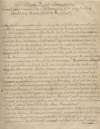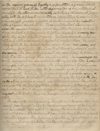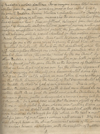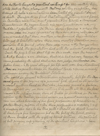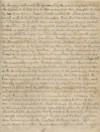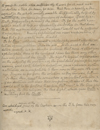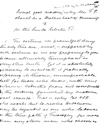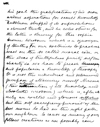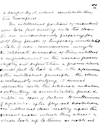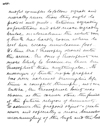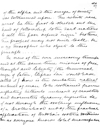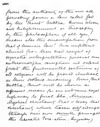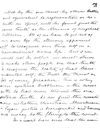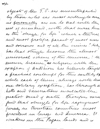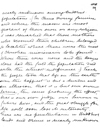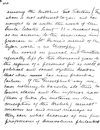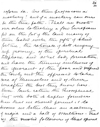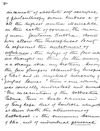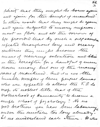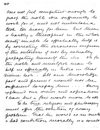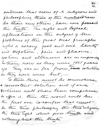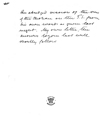Maha Chohan Letter: Difference between revisions
No edit summary |
m (Image shows the word "deduced" not "deducted" also makes more sense in the context of the letter.) |
||
| (56 intermediate revisions by 3 users not shown) | |||
| Line 7: | Line 7: | ||
| writtendate = late 1881 or early 1882 | | writtendate = late 1881 or early 1882 | ||
| receiveddate = late 1881 or early 1882 | | receiveddate = late 1881 or early 1882 | ||
| otherdate = | | otherdate = unknown{{pad|10em}} | ||
| header3 = Places | | header3 = Places | ||
| sentfrom = unknown | | sentfrom = unknown | ||
| receivedat = Simla | | receivedat = Simla | ||
| vialocation = | | vialocation = unknown | ||
}} | }} | ||
The '''Maha Chohan Letter''', also known as the Great Master's Letter, | The '''Maha Chohan Letter''', also known as the Great Master's Letter, appears in print as '''Appendix II''' in ''' [[The Mahatma Letters to A. P. Sinnett (book)|''The Mahatma Letters to A. P. Sinnett'']], 4th chronological edition'''. It was also published as '''Letter No. 1''' in '''[[Letters from the Masters of the Wisdom (book)|''Letters from the Masters of the Wisdom, 1881-1888'']]'''.<ref>C. Jinarajadasa, ''Letters from the Masters of the Wisdom, First Series'' (Adyar, Chennai, India: Theosophical Publishing House, 2011), 33-11, 130-136.</ref> This letter, produced around 1881, is a summary by [[Koot Hoomi|Mahatma K.H.]] of a conversation held with the Maha Chohan in reference to some arguments [[A. P. Sinnett]] and [[A. O. Hume]] were posing about reforming the nature of the [[Theosophical Society]]. For more information see below [[Maha_Chohan_Letter#Context and background|Context and background]]. | ||
This is considered to be the most important letter received from the [[Mahatmas]], for it contains the views of the [[Maha Chohan]] on the [[Theosophical Society]]. The original letter has not been available, and Theosophists relied on copies of it made by several people. Here we reproduce images of a new copy provided by a private archival collection, and they are followed by copies made in [[A. P. Sinnett|Sinnett]]'s handwriting. | |||
<br> | <br> | ||
<br> | |||
<big>[[First Letter from K.H. to A. O. Hume|'''<nowiki> < </nowiki>'''Prev letter chrono]]</big>{{pad|3em}} | |||
{{pad|12em}} | |||
<br> | <br> | ||
{{pad|12em}} | {{pad|12em}} | ||
| Line 27: | Line 29: | ||
== Page 1 transcription, image, and notes == | == Page 1 transcription, image, and notes == | ||
{{Col-begin|width=98%}} | |||
{{Col-break|width=55%}} | |||
(<u><span style="border-bottom: 1px double #000;">Strictly</span></u>) (<u><span style="border-bottom: 1px double #000;">Private</span></u>) & (<u><span style="border-bottom: 1px double #000;">Confidential</span></u>) | |||
Several good reasons, given to [[Koot Hoomi|Mahatma K.H.]] [by the [[Maha Chohan|Chohan]]<nowiki>]</nowiki>, why the [[Theosophical Society|T.S.]] should be a [[Universal Brotherhood|<u>Brotherhood</u> of <u>Humanity</u>]]. | |||
<center>______</center> | |||
The doctrine we promulgate, being the only true one, must - supported by such evidence as we are preparing to give - become ultimately triumphant as every other truth. Yet it is absolutely necessary to inculcate it gradually enforcing its theories, unimpeachable facts for those who know, with direct inferences deduced from and corroborated by the evidence furnished by modern exact science. That is why [[Henry Steel Olcott|Col. H.S.O.]] who works but to revive [[Buddhism]] may be regarded as one who labours in the true path of [[theosophy]], far more than any other man who chooses as his goal the gratification of his own ardent aspirations for [[occultism|occult]] knowledge. Buddhism stripped of its superstitions is eternal truth, and he who strives for the latter is striving for theo-sophia - Divine Wisdom, which is a synonym of truth. | |||
For our doctrines to practically re-act on the so-called moral code or the ideas of truthfulness, purity, self-denial, charity, etc., we have to preach and popularise a knowledge of Theosophy. It is not the individual and determined purpose of attaining oneself [[Nirvāṇa|Nirvana]] (the culmination of all knowledge and absolute wisdom) which is, after all only an exalted and glorious <u>selfishness</u>, but the self-sacrificing pursuit of the best means to lead on the right path our neighbour, to cause as many of our fellow creatures as we possibly can to benefit by it, which constitutes the true Theosophist. | |||
The intellectual portions of mankind seem to be fast dividing into two classes, the one unconsciously preparing for itself long periods of temporary annihilation or states of non-consciousness owing to the deliberate surrender of their [[Manas|intellect]], its imprisonment | |||
{{Col-break|width=3%}} | |||
{{Col-break|width=15%}} | |||
[http://www.theosophy.wiki/mywiki/images/ML/LMW1-1_1.jpg http://www.theosophy.wiki/mywiki/images/ML/LMW1-1_1_thm.jpg] | |||
{{Col-break|width=30%}} | |||
'''NOTES:''' | |||
* | |||
{{Col-end}} | |||
== Page 2 == | |||
{{Col-begin|width=98%}} | |||
{{Col-break|width=55%}} | |||
in the narrow grooves of bigotry and superstition, a process which cannot fail to lead to the utter deformation of the intellectual principle; the other unrestrainedly indulging its [[Kāma|animal propensities]] with the deliberate intention of <u>submitting</u> to annihilation pure and simple in cases of failure, to millenniums of degradation after physical dissolution. Those "intellectual classes," reacting upon the ignorant masses which they attract and which look up to them as noble and fit examples to follow, degrade and morally ruin those they ought to protect and guide. Between degrading superstition and still more degrading brutal materialism the white dove of truth has hardly room where to rest her weary unwelcome foot. . . . | |||
It's time that [[Theosophy]] should enter the arena. The sons of [[Theosophist]]s are more likely to become in their turn Theosophists than anything else. No messenger of truth, no prophet has ever achieved during his life time a complete triumph, not even [[Gautama Buddha|Buddha]]. The [[Theosophical Society]] was chosen as the corner stone, the foundation of the future religion of humanity. To achieve the proposed objects a greater, wiser, and especially a more benevolent intermingling of the high and the low, of the alpha and the omega of society, was determined upon. The white race must be the first to stretch out the hand of fellowship to the dark nations, to call the poor despised "nigger" - brother. This prospect may not smile to all; - He is no Theosophist who objects to this principle. | |||
In view of the ever increasing triumph and at the same time misuse of free-thought and <u>liberty</u> (the Universal reign of [[Lucifer#Satan_as_the_opposer|Satan]], [[Éliphas Lévi Zahed|Eliphas Levi]] would have called it), how is the combative <u>natural</u> instinct of man to be restrained from inflicting hitherto unheard of cruelties and enormities, tyranny, injustice, etc., if not through the soothing influence of a [[Universal Brotherhood|brotherhood]] and of the practical application | |||
{{Col-break|width=3%}} | |||
{{Col-break|width=15%}} | |||
[http://www.theosophy.wiki/mywiki/images/ML/LMW1-1_2.jpg http://www.theosophy.wiki/mywiki/images/ML/LMW1-1_2_thm.jpg] | |||
{{Col-break|width=30%}} | |||
'''NOTES:''' | |||
* '''the alpha and the omega of society''' indicates the full range of society. Alpha and omega are the first and last letters of the Greek alphabet. | |||
{{Col-end}} | |||
== Page 3 == | |||
{{Col-begin|width=98%}} | |||
{{Col-break|width=55%}} | |||
of Buddha's esoteric doctrines? | |||
For as everyone knows, total emancipation from [authority of] the one all pervading power or law called [[God]] by the Theists — [[Buddha]], [[Wisdom#Divine_wisdom|Divine Wisdom]] and Enlightenment or Theosophy by the philosophers of all ages — means also the emancipation from that of human law. Once unfettered [and] delivered from their dead weight of dogmatic interpretations, personal names, anthropomorphic conceptions and salaried priests, the fundamental doctrines of all religions will be proved identical in their esoteric meaning. [[Osiris]], [[Kṛṣṇa|Chrishna]], [[Buddha]], Christ, will be shown as different means for one and the same royal highway to final bliss - [[Nirvāṇa|Nirvana]]. | |||
Mystical [[Christianity]], that is to say that Christianity which teaches <u>self</u>-redemption through one's own [[Ātman|seventh principle]] — this liberated Para-âtma ([[Augoeides]]) called by the one Christ, by others Buddha, and equivalent to regeneration or rebirth in spirit — will be found just the same truth as the [[Nirvāṇa|Nirvana]] of mystical [[Buddhism]]. All of us have to get rid of our own [[Ego]], the illusory apparent self, to recognise our true self in a transcendental divine life. But if we would not be selfish we must strive to make other people see that truth, to recognise the reality of that transcendental self, the Buddh, the Christ or [[God]] of every preacher. This is why even exoteric Buddhism is the surest path to lead men toward the one esoteric truth. As we find the world now, whether Christian, Mussalman or Pagan, justice is disregarded and honour and mercy both flung to the winds. | |||
In a word, how, once that the main [[Objects of the Theosophical Society|objects of the T.S.]] are misinterpreted by those who are most willing to serve us personally, are we to deal with the rest of mankind, with that curse known as the "struggle for life," which is the real and most prolific parent of most woes and sorrows and of all the crimes? Why has that struggle become the almost universal scheme of the universe? We answer, because no religion with the exception of [[Buddhism]] | |||
{{Col-break|width=3%}} | |||
{{Col-break|width=15%}} | |||
[http://www.theosophy.wiki/mywiki/images/ML/LMW1-1_3.jpg http://www.theosophy.wiki/mywiki/images/ML/LMW1-1_3_thm.jpg] | |||
{{Col-break|width=30%}} | |||
'''NOTES:''' | |||
* | |||
{{Col-end}} | |||
== Page 4 == | |||
{{Col-begin|width=98%}} | |||
{{Col-break|width=55%}} | |||
has hitherto taught a practical contempt for this earthly life, while each of them, always with that one solitary exception, has through its [[hell]]s and damnations inculcated the greatest dread of [[death]]. Therefore do we find that struggle for life raging most fiercely in [[Christianity|Christian]] countries, most prevalent in Europe and America. It weakens in the Pagan lands and is nearly unknown among Buddhist populations. (In China during famine and where the masses are most ignorant of their own or any religion, it was remarked that those mothers who devoured their children belonged to localities where there were the most of Christian missionaries to be found. Where there were none and the Bonzes alone had the field the population died with the utmost indifference.) Teach the people to see that life on this earth even the happiest is but a burden and an [[Māyā|illusion]], that it is but our own [[Karma]], the cause producing the effect, that is our own judge, our Saviour in [[Reincarnation|future lives]], and the great struggle for life will soon lose its intensity. There are no penitentiaries in Buddhist lands and crime is nearly unknown among the [[Vajrayāna|Buddhist Tibetans]]. (The above is not addressed to you, and has naught to do with the work of the [[Simla Eclectic Theosophical Society|Simla Eclectic Society]]. It is meant only as an answer to the erroneous impression in [[A. O. Hume|Mr. Hume]]'s mind of the "Ceylon work" as no [[theosophy]].) | |||
The world in general and Christendom especially, left for two thousand years to the regime of a [[God|personal God]] as well as its political and social systems based on that idea, has now proved a failure. If the [[Theosophist]]s say, we have nothing to do with all this, the lower classes and the inferior races (those of India for instance in the conception of the British) cannot concern us and must manage as they can, what becomes of our fine professions of benevolence, philanthropy, reform, etc. Are these professions a mockery? And if a mockery, can ours be the true path? Should we devote our selves to teaching a few Europeans fed on the fat of the land, many of them loaded with the gifts of blind fortune, the rationale of bell-ringing, cup-growing, of the spiritual telephone [and [[Astral Body|astral body]] formation], and leave | |||
{{Col-break|width=3%}} | |||
{{Col-break|width=15%}} | |||
[http://www.theosophy.wiki/mywiki/images/ML/LMW1-1_4.jpg http://www.theosophy.wiki/mywiki/images/ML/LMW1-1_4_thm.jpg] | |||
{{Col-break|width=30%}} | |||
'''NOTES:''' | |||
* | |||
{{Col-end}} | |||
== Page 5 == | |||
{{Col-begin|width=98%}} | |||
{{Col-break|width=55%}} | |||
the teeming millions of the ignorant, of the poor and despised, the lowly and the oppressed, to take care of themselves and of their hereafter the best they know how. Never. Perish rather the [[Theosophical Society]] with both its hapless [[Founders#"The Founders"|founders]] than that we should permit it to become no better than an academy of [[magic]] and a hall of [[occultism]]. That <u>we</u> the devoted followers of that spirit incarnate of absolute self sacrifice, of philanthropy, divine kindness, as of all the highest virtues attainable on this earth of sorrow, the man of men, [[Gautama Buddha]], should ever allow the Theosophical Society to represent the <u>embodiment of selfishness</u>, the refuge of the few with no thought in them for the many, is a strange idea, my brothers. | |||
Among the few glimpses obtained by Europeans of Tibet and its mystical hierarchy of "perfect [[lama]]s," there is one which was correctly understood and described. "The incarnations of the Boddisatwa Padma Pani or [[Avalokiteśvara|Avalo-Kiteswara]] and of [[Tsongkhapa|Tsong Kapa]], that of Amitabha, relinquish at their death the attainment of Buddhahood — i.e. the summum bonum of bliss, and of individual personal felicity that they might be born again and again for the benefit of mankind."<ref>Clements Robert Markham, ''Narratives of the Mission of George Bogle to Tibet''. In the printed versions this quote is wrongly assigned to [[Thomas William Rhys Davids|Rhys Davids]].</ref> In other words, that they might be again and again subjected to misery, imprisonment in flesh and all the sorrows of life, provided that by such a self sacrifice repeated throughout long and dreary centuries they might become the means of securing salvation and bliss in the hereafter for a handful of men chosen among but one of the many races of mankind. And it is we, the humble disciples of these perfect lamas, who are expected to allow the [[Theosophical Society|T.S.]] to drop its noblest title, that of the Brotherhood of Humanity to become a simple school of psychology? No, no, good brothers, you have been labouring under the mistake too long already. Let us understand each other. He who does not feel competent enough | |||
{{Col-break|width=3%}} | |||
{{Col-break|width=15%}} | |||
[http://www.theosophy.wiki/mywiki/images/ML/LMW1-1_5.jpg http://www.theosophy.wiki/mywiki/images/ML/LMW1-1_5_thm.jpg] | |||
{{Col-break|width=30%}} | |||
'''NOTES:''' | |||
* '''”Perfect Lamas”''' evidently is a term used at the time to refer to the Bodhisattvas. Blavatsky also quotes the phrase “perfect Lamas or Bodhisatvas” in her article “Who are the Aryas and the Buddhists.” H. P. Blavatsky Collected Writings Vol. 3, p. 303 | |||
* '''Summum bonum''' is a Latin expression for "the highest good." | |||
{{Col-end}} | |||
== Page 6 == | |||
{{Col-begin|width=98%}} | |||
{{Col-break|width=55%}} | |||
to grasp the noble idea sufficiently to work for it, need not undertake a task too heavy for him. But there is hardly a theosophist in the whole society unable to effectually help it by correcting the erroneous impressions of the outsiders, if not by actually propagating himself the idea. Oh, for the noble and unselfish man to help us <u>effectually</u> in India in that divine task. All our knowledge past and present would not be sufficient to repay him. . . . Having explained our views and aspirations I have but a few words more to add. | |||
To be <u>true</u>, [[religion]] and philosophy must offer the solution of every problem. That the world is in such a bad condition morally is a conclusive evidence that none of its religions and philosophies, those of the <u>civilised</u> races less than any other, have ever possessed the <u>truth</u>. The right and logical explanations on the subject of the problems of the great dual principles — right and wrong, good and evil, liberty and despotism, pain and pleasure, egotism and altruism — are as impossible to them now as they were 1881 years ago. They are as far from the solution as they ever were but, –––– | |||
To these there <u>must</u> be somewhere a consistent solution, and if our doctrines will show their competence to offer it, then the world will be the first one to confess that must be the true philosophy, the true religion, the true light, which gives <u>truth</u> and nothing but the <u>truth</u>. | |||
<center>----------------------</center> | |||
An abridged version of the view of the [[Maha Chohan|Chohan]] on the [[Theosophical Society|T.S.]] from his own words. | |||
::::Signed. K.H. | |||
[[File:Six-pointed star with central dot.JPG|center|25px]] | |||
{{Col-break|width=3%}} | |||
{{Col-break|width=15%}} | |||
[http://www.theosophy.wiki/mywiki/images/ML/LMW1-1_6.jpg http://www.theosophy.wiki/mywiki/images/ML/LMW1-1_6_thm.jpg] | |||
{{Col-break|width=30%}} | |||
'''NOTES:''' | |||
* | |||
{{Col-end}} | |||
== Sinnett Transcription Page 1 == | |||
{{Col-begin|width=98%}} | {{Col-begin|width=98%}} | ||
{{Col-break|width=55%}} | {{Col-break|width=55%}} | ||
| Line 37: | Line 176: | ||
{{Col-break|width=15%}} | {{Col-break|width=15%}} | ||
[http://www.theosophy.wiki/mywiki/images/ML/MC1.jpg http://www.theosophy.wiki/mywiki/images/ML/MC1_thm.jpg] | [http://www.theosophy.wiki/mywiki/images/ML/MC1.jpg http://www.theosophy.wiki/mywiki/images/ML/MC1_thm.jpg] | ||
| Line 45: | Line 185: | ||
{{Col-end}} | {{Col-end}} | ||
== Page 2 == | == Sinnett Transcription Page 2 == | ||
{{Col-begin|width=98%}} | {{Col-begin|width=98%}} | ||
{{Col-break|width=55%}} | {{Col-break|width=55%}} | ||
his goal the gratification of his own ardent aspirations for [[occultism|occult]] knowledge. Buddhism stripped of its superstitions is eternal truth, and he who strives for the latter is striving for | his goal the gratification of his own ardent aspirations for [[occultism|occult]] knowledge. Buddhism stripped of its superstitions is eternal truth, and he who strives for the latter is striving for theo-sophia, Divine Wisdom, which is a synonym of truth. | ||
For our doctrines to practically react on the so called moral code or the ideas of truthfulness, purity, self-denial, charity, etc., we have to preach and popularise a knowledge of theosophy. It is not the individual and determined purpose of attaining oneself [[Nirvāṇa|Nirvana]] (the culmination of all knowledge and absolute wisdom) which is, after all only an exalted and glorious selfishness, but the self-sacrificing pursuit of the best means to lead on the right path our neighbour, to cause as many of our fellow creatures as we possibly can | For our doctrines to practically react on the so called moral code or the ideas of truthfulness, purity, self-denial, charity, etc., we have to preach and popularise a knowledge of theosophy. It is not the individual and determined purpose of attaining oneself [[Nirvāṇa|Nirvana]] (the culmination of all knowledge and absolute wisdom) which is, after all only an exalted and glorious selfishness, but the self-sacrificing pursuit of the best means to lead on the right path our neighbour, to cause as many of our fellow creatures as we possibly can | ||
| Line 55: | Line 195: | ||
{{Col-break|width=3%}} | {{Col-break|width=3%}} | ||
{{Col-break|width=15%}} | {{Col-break|width=15%}} | ||
[http://www.theosophy.wiki/mywiki/images/ML/MC2.jpg http://www.theosophy.wiki/mywiki/images/ML/MC2_thm.jpg] | [http://www.theosophy.wiki/mywiki/images/ML/MC2.jpg http://www.theosophy.wiki/mywiki/images/ML/MC2_thm.jpg] | ||
{{Col-break|width=30%}} | {{Col-break|width=30%}} | ||
| Line 64: | Line 204: | ||
{{Col-end}} | {{Col-end}} | ||
== Page 3 == | == Sinnett Transcription Page 3 == | ||
{{Col-begin|width=98%}} | {{Col-begin|width=98%}} | ||
{{Col-break|width=55%}} | {{Col-break|width=55%}} | ||
| Line 83: | Line 223: | ||
{{Col-end}} | {{Col-end}} | ||
== Page 4 == | == Sinnett Transcription Page 4 == | ||
{{Col-begin|width=98%}} | {{Col-begin|width=98%}} | ||
{{Col-break|width=55%}} | {{Col-break|width=55%}} | ||
| Line 94: | Line 234: | ||
{{Col-break|width=15%}} | {{Col-break|width=15%}} | ||
[http://www.theosophy.wiki/mywiki/images/ML/MC4.jpg http://www.theosophy.wiki/mywiki/images/ML/MC4_thm.jpg] | [http://www.theosophy.wiki/mywiki/images/ML/MC4.jpg http://www.theosophy.wiki/mywiki/images/ML/MC4_thm.jpg] | ||
{{Col-break|width=30%}} | {{Col-break|width=30%}} | ||
| Line 102: | Line 241: | ||
{{Col-end}} | {{Col-end}} | ||
== Page 5 == | == Sinnett Transcription Page 5 == | ||
{{Col-begin|width=98%}} | {{Col-begin|width=98%}} | ||
{{Col-break|width=55%}} | {{Col-break|width=55%}} | ||
| Line 115: | Line 254: | ||
{{Col-break|width=15%}} | {{Col-break|width=15%}} | ||
[http://www.theosophy.wiki/mywiki/images/ML/MC5.jpg http://www.theosophy.wiki/mywiki/images/ML/MC5_thm.jpg] | [http://www.theosophy.wiki/mywiki/images/ML/MC5.jpg http://www.theosophy.wiki/mywiki/images/ML/MC5_thm.jpg] | ||
{{Col-break|width=30%}} | {{Col-break|width=30%}} | ||
| Line 123: | Line 261: | ||
{{Col-end}} | {{Col-end}} | ||
== Page 6 == | == Sinnett Transcription Page 6 == | ||
{{Col-begin|width=98%}} | {{Col-begin|width=98%}} | ||
{{Col-break|width=55%}} | {{Col-break|width=55%}} | ||
| Line 141: | Line 279: | ||
{{Col-end}} | {{Col-end}} | ||
== Page 7 == | == Sinnett Transcription Page 7 == | ||
{{Col-begin|width=98%}} | {{Col-begin|width=98%}} | ||
{{Col-break|width=55%}} | {{Col-break|width=55%}} | ||
| Line 158: | Line 296: | ||
{{Col-end}} | {{Col-end}} | ||
== Page 8 == | == Sinnett Transcription Page 8 == | ||
{{Col-begin|width=98%}} | {{Col-begin|width=98%}} | ||
{{Col-break|width=55%}} | {{Col-break|width=55%}} | ||
| Line 174: | Line 312: | ||
{{Col-end}} | {{Col-end}} | ||
== Page 9 == | == Sinnett Transcription Page 9 == | ||
{{Col-begin|width=98%}} | {{Col-begin|width=98%}} | ||
{{Col-break|width=55%}} | {{Col-break|width=55%}} | ||
| Line 190: | Line 328: | ||
{{Col-end}} | {{Col-end}} | ||
== Page 10 == | == Sinnett Transcription Page 10 == | ||
{{Col-begin|width=98%}} | {{Col-begin|width=98%}} | ||
{{Col-break|width=55%}} | {{Col-break|width=55%}} | ||
| Line 208: | Line 346: | ||
{{Col-end}} | {{Col-end}} | ||
== Page 11 == | == Sinnett Transcription Page 11 == | ||
{{Col-begin|width=98%}} | {{Col-begin|width=98%}} | ||
{{Col-break|width=55%}} | {{Col-break|width=55%}} | ||
| Line 224: | Line 362: | ||
{{Col-end}} | {{Col-end}} | ||
== Page 12 == | == Sinnett Transcription Page 12 == | ||
{{Col-begin|width=98%}} | {{Col-begin|width=98%}} | ||
{{Col-break|width=55%}} | {{Col-break|width=55%}} | ||
| Line 234: | Line 372: | ||
{{Col-break|width=15%}} | {{Col-break|width=15%}} | ||
[http://www.theosophy.wiki/mywiki/images/ML/MC12.jpg http://www.theosophy.wiki/mywiki/images/ML/MC12_thm.jpg] | [http://www.theosophy.wiki/mywiki/images/ML/MC12.jpg http://www.theosophy.wiki/mywiki/images/ML/MC12_thm.jpg] | ||
{{Col-break|width=30%}} | {{Col-break|width=30%}} | ||
| Line 243: | Line 379: | ||
{{Col-end}} | {{Col-end}} | ||
== Page 13 == | == Sinnett Transcription Page 13 == | ||
{{Col-begin|width=98%}} | {{Col-begin|width=98%}} | ||
{{Col-break|width=55%}} | {{Col-break|width=55%}} | ||
| Line 251: | Line 387: | ||
{{Col-break|width=15%}} | {{Col-break|width=15%}} | ||
[http://www.theosophy.wiki/mywiki/images/ML/MC13.jpg http://www.theosophy.wiki/mywiki/images/ML/MC13_thm.jpg] | [http://www.theosophy.wiki/mywiki/images/ML/MC13.jpg http://www.theosophy.wiki/mywiki/images/ML/MC13_thm.jpg] | ||
{{Col-break|width=30%}} | {{Col-break|width=30%}} | ||
| Line 259: | Line 394: | ||
{{Col-end}} | {{Col-end}} | ||
== Page 14 == | == Sinnett Transcription Page 14 == | ||
{{Col-begin|width=98%}} | {{Col-begin|width=98%}} | ||
{{Col-break|width=55%}} | {{Col-break|width=55%}} | ||
| Line 276: | Line 411: | ||
{{Col-end}} | {{Col-end}} | ||
== Page 15 == | == Sinnett Transcription Page 15 == | ||
{{Col-begin|width=98%}} | {{Col-begin|width=98%}} | ||
{{Col-break|width=55%}} | {{Col-break|width=55%}} | ||
| Line 294: | Line 429: | ||
{{Col-end}} | {{Col-end}} | ||
== Page 16 == | == Sinnett Transcription Page 16 == | ||
{{Col-begin|width=98%}} | {{Col-begin|width=98%}} | ||
{{Col-break|width=55%}} | {{Col-break|width=55%}} | ||
An abridged version of the view of the [[Maha Chohan|Chohan]] on the [[Theosophical Society|T.S.]] from his own words as given last night. My own letter, the answer to yours, will shortly follow. | An abridged version of the view of the [[Maha Chohan|Chohan]] on the [[Theosophical Society|T.S.]] from his own words as given last night. My own letter, the answer to yours, will shortly follow. | ||
{{Col-break|width=3%}} | {{Col-break|width=3%}} | ||
| Line 305: | Line 439: | ||
{{Col-break|width=15%}} | {{Col-break|width=15%}} | ||
[http://www.theosophy.wiki/mywiki/images/ML/MC16.jpg http://www.theosophy.wiki/mywiki/images/ML/MC16_thm.jpg] | [http://www.theosophy.wiki/mywiki/images/ML/MC16.jpg http://www.theosophy.wiki/mywiki/images/ML/MC16_thm.jpg] | ||
{{Col-break|width=30%}} | {{Col-break|width=30%}} | ||
| Line 321: | Line 454: | ||
== Physical description of letter == | == Physical description of letter == | ||
The original of this letter is | The first transcription shown above, purportedly the original of this letter, is in a private collection. [[Alfred Percy Sinnett|A. P. Sinnett's]] copy is at the British Library.<ref>British Library Folio 6 Additional MS 45289A.</ref> [[Curuppumullage Jinarājadāsa|Mr. Jinarājadāsa]] wrote: | ||
<blockquote> | <blockquote> | ||
But fortunately for us, copies were made, under instructions from the two Masters, of such parts of their communications to Mr Sinnett and Mr Hume as were instructional in their nature, and which gave an idea of the esoteric philosophy. This letter was copied and cyclostyled in London, and sent to certain selected persons. One such copy is among the papers of [[Charles Webster Leadbeater|C. W. Leadbeater]], and I published the letter from it in my edition of 1919... I found a manuscript volume, in the handwriting of [[Francesca Arundale|Miss Francesca Arundale]], which contained, among other extracts from the letters, this Letter 1. I have recopied the letter from these two manuscripts.<ref>C. Jinarajadasa, 135.</ref> | But fortunately for us, copies were made, under instructions from the two Masters, of such parts of their communications to Mr Sinnett and Mr Hume as were instructional in their nature, and which gave an idea of the esoteric philosophy. This letter was copied and cyclostyled in London, and sent to certain selected persons. One such copy is among the papers of [[Charles Webster Leadbeater|C. W. Leadbeater]], and I published the letter from it in my edition of 1919... I found a manuscript volume, in the handwriting of [[Francesca Arundale|Miss Francesca Arundale]], which contained, among other extracts from the letters, this Letter 1. I have recopied the letter from these two manuscripts.<ref>C. Jinarajadasa, 135.</ref> | ||
</blockquote> | </blockquote> | ||
== Publication history == | == Publication history == | ||
| Line 344: | Line 477: | ||
insight the future lies like an open page’ — [[Koot Hoomi|K.H.]], [[Mahatma Letter to H. S. Olcott - LMW 1 No. 16|Letter 16]]), one of the three great [[Adept|Adepts]] who form the ‘triangle’ of the great [[Brotherhood of Adepts|Hierarchy]]. As the note from the Master KH says, the communication is not a letter written by the Maha Chohan himself, but the report of an interview.<ref>C. Jinarajadasa and unnamed subsequent editors, 130.</ref> | insight the future lies like an open page’ — [[Koot Hoomi|K.H.]], [[Mahatma Letter to H. S. Olcott - LMW 1 No. 16|Letter 16]]), one of the three great [[Adept|Adepts]] who form the ‘triangle’ of the great [[Brotherhood of Adepts|Hierarchy]]. As the note from the Master KH says, the communication is not a letter written by the Maha Chohan himself, but the report of an interview.<ref>C. Jinarajadasa and unnamed subsequent editors, 130.</ref> | ||
</blockquote> | </blockquote> | ||
For additional commentary see [https://archive.org/details/JinarajadasaTheMahaChohansLetterWithACommentary '''''The Maha Chohan's Letter with Commentary 1881]'''. | |||
== Notes == | == Notes == | ||
| Line 349: | Line 484: | ||
[[Category:ML from Maha Chohan]] | [[Category:ML from Maha Chohan]] | ||
[[Category:ML to A. P. Sinnett]] | |||
[[Category:ML to a group]] | |||
[[Category:ML with images|Maha Chohan Letter]] | |||
[[Category:ML with images|LMW1-1]] | |||
[[es:Carta del Maha Chohan]] | [[es:Carta del Maha Chohan]] | ||
Latest revision as of 18:02, 1 June 2024
| Quick Facts | |
|---|---|
| People involved | |
| Written by: | Maha Chohan, Koot Hoomi |
| Received by: | A.P. Sinnett, Simla Eclectic TS |
| Sent via: | an accepted chela |
| Dates | |
| Written on: | late 1881 or early 1882 |
| Received on: | late 1881 or early 1882 |
| Other dates: | unknown |
| Places | |
| Sent from: | unknown |
| Received at: | Simla |
| Via: | unknown |
The Maha Chohan Letter, also known as the Great Master's Letter, appears in print as Appendix II in The Mahatma Letters to A. P. Sinnett, 4th chronological edition. It was also published as Letter No. 1 in Letters from the Masters of the Wisdom, 1881-1888.[1] This letter, produced around 1881, is a summary by Mahatma K.H. of a conversation held with the Maha Chohan in reference to some arguments A. P. Sinnett and A. O. Hume were posing about reforming the nature of the Theosophical Society. For more information see below Context and background.
This is considered to be the most important letter received from the Mahatmas, for it contains the views of the Maha Chohan on the Theosophical Society. The original letter has not been available, and Theosophists relied on copies of it made by several people. Here we reproduce images of a new copy provided by a private archival collection, and they are followed by copies made in Sinnett's handwriting.
< Prev letter chrono
Next letter in LMW 1 >
Page 1 transcription, image, and notes
|
(Strictly) (Private) & (Confidential) Several good reasons, given to Mahatma K.H. [by the Chohan], why the T.S. should be a Brotherhood of Humanity. The doctrine we promulgate, being the only true one, must - supported by such evidence as we are preparing to give - become ultimately triumphant as every other truth. Yet it is absolutely necessary to inculcate it gradually enforcing its theories, unimpeachable facts for those who know, with direct inferences deduced from and corroborated by the evidence furnished by modern exact science. That is why Col. H.S.O. who works but to revive Buddhism may be regarded as one who labours in the true path of theosophy, far more than any other man who chooses as his goal the gratification of his own ardent aspirations for occult knowledge. Buddhism stripped of its superstitions is eternal truth, and he who strives for the latter is striving for theo-sophia - Divine Wisdom, which is a synonym of truth. For our doctrines to practically re-act on the so-called moral code or the ideas of truthfulness, purity, self-denial, charity, etc., we have to preach and popularise a knowledge of Theosophy. It is not the individual and determined purpose of attaining oneself Nirvana (the culmination of all knowledge and absolute wisdom) which is, after all only an exalted and glorious selfishness, but the self-sacrificing pursuit of the best means to lead on the right path our neighbour, to cause as many of our fellow creatures as we possibly can to benefit by it, which constitutes the true Theosophist. The intellectual portions of mankind seem to be fast dividing into two classes, the one unconsciously preparing for itself long periods of temporary annihilation or states of non-consciousness owing to the deliberate surrender of their intellect, its imprisonment |
NOTES: |
Page 2
|
in the narrow grooves of bigotry and superstition, a process which cannot fail to lead to the utter deformation of the intellectual principle; the other unrestrainedly indulging its animal propensities with the deliberate intention of submitting to annihilation pure and simple in cases of failure, to millenniums of degradation after physical dissolution. Those "intellectual classes," reacting upon the ignorant masses which they attract and which look up to them as noble and fit examples to follow, degrade and morally ruin those they ought to protect and guide. Between degrading superstition and still more degrading brutal materialism the white dove of truth has hardly room where to rest her weary unwelcome foot. . . . It's time that Theosophy should enter the arena. The sons of Theosophists are more likely to become in their turn Theosophists than anything else. No messenger of truth, no prophet has ever achieved during his life time a complete triumph, not even Buddha. The Theosophical Society was chosen as the corner stone, the foundation of the future religion of humanity. To achieve the proposed objects a greater, wiser, and especially a more benevolent intermingling of the high and the low, of the alpha and the omega of society, was determined upon. The white race must be the first to stretch out the hand of fellowship to the dark nations, to call the poor despised "nigger" - brother. This prospect may not smile to all; - He is no Theosophist who objects to this principle. In view of the ever increasing triumph and at the same time misuse of free-thought and liberty (the Universal reign of Satan, Eliphas Levi would have called it), how is the combative natural instinct of man to be restrained from inflicting hitherto unheard of cruelties and enormities, tyranny, injustice, etc., if not through the soothing influence of a brotherhood and of the practical application |
NOTES:
|
Page 3
|
of Buddha's esoteric doctrines? For as everyone knows, total emancipation from [authority of] the one all pervading power or law called God by the Theists — Buddha, Divine Wisdom and Enlightenment or Theosophy by the philosophers of all ages — means also the emancipation from that of human law. Once unfettered [and] delivered from their dead weight of dogmatic interpretations, personal names, anthropomorphic conceptions and salaried priests, the fundamental doctrines of all religions will be proved identical in their esoteric meaning. Osiris, Chrishna, Buddha, Christ, will be shown as different means for one and the same royal highway to final bliss - Nirvana. Mystical Christianity, that is to say that Christianity which teaches self-redemption through one's own seventh principle — this liberated Para-âtma (Augoeides) called by the one Christ, by others Buddha, and equivalent to regeneration or rebirth in spirit — will be found just the same truth as the Nirvana of mystical Buddhism. All of us have to get rid of our own Ego, the illusory apparent self, to recognise our true self in a transcendental divine life. But if we would not be selfish we must strive to make other people see that truth, to recognise the reality of that transcendental self, the Buddh, the Christ or God of every preacher. This is why even exoteric Buddhism is the surest path to lead men toward the one esoteric truth. As we find the world now, whether Christian, Mussalman or Pagan, justice is disregarded and honour and mercy both flung to the winds. In a word, how, once that the main objects of the T.S. are misinterpreted by those who are most willing to serve us personally, are we to deal with the rest of mankind, with that curse known as the "struggle for life," which is the real and most prolific parent of most woes and sorrows and of all the crimes? Why has that struggle become the almost universal scheme of the universe? We answer, because no religion with the exception of Buddhism |
NOTES: |
Page 4
|
has hitherto taught a practical contempt for this earthly life, while each of them, always with that one solitary exception, has through its hells and damnations inculcated the greatest dread of death. Therefore do we find that struggle for life raging most fiercely in Christian countries, most prevalent in Europe and America. It weakens in the Pagan lands and is nearly unknown among Buddhist populations. (In China during famine and where the masses are most ignorant of their own or any religion, it was remarked that those mothers who devoured their children belonged to localities where there were the most of Christian missionaries to be found. Where there were none and the Bonzes alone had the field the population died with the utmost indifference.) Teach the people to see that life on this earth even the happiest is but a burden and an illusion, that it is but our own Karma, the cause producing the effect, that is our own judge, our Saviour in future lives, and the great struggle for life will soon lose its intensity. There are no penitentiaries in Buddhist lands and crime is nearly unknown among the Buddhist Tibetans. (The above is not addressed to you, and has naught to do with the work of the Simla Eclectic Society. It is meant only as an answer to the erroneous impression in Mr. Hume's mind of the "Ceylon work" as no theosophy.) The world in general and Christendom especially, left for two thousand years to the regime of a personal God as well as its political and social systems based on that idea, has now proved a failure. If the Theosophists say, we have nothing to do with all this, the lower classes and the inferior races (those of India for instance in the conception of the British) cannot concern us and must manage as they can, what becomes of our fine professions of benevolence, philanthropy, reform, etc. Are these professions a mockery? And if a mockery, can ours be the true path? Should we devote our selves to teaching a few Europeans fed on the fat of the land, many of them loaded with the gifts of blind fortune, the rationale of bell-ringing, cup-growing, of the spiritual telephone [and astral body formation], and leave |
NOTES: |
Page 5
|
the teeming millions of the ignorant, of the poor and despised, the lowly and the oppressed, to take care of themselves and of their hereafter the best they know how. Never. Perish rather the Theosophical Society with both its hapless founders than that we should permit it to become no better than an academy of magic and a hall of occultism. That we the devoted followers of that spirit incarnate of absolute self sacrifice, of philanthropy, divine kindness, as of all the highest virtues attainable on this earth of sorrow, the man of men, Gautama Buddha, should ever allow the Theosophical Society to represent the embodiment of selfishness, the refuge of the few with no thought in them for the many, is a strange idea, my brothers. Among the few glimpses obtained by Europeans of Tibet and its mystical hierarchy of "perfect lamas," there is one which was correctly understood and described. "The incarnations of the Boddisatwa Padma Pani or Avalo-Kiteswara and of Tsong Kapa, that of Amitabha, relinquish at their death the attainment of Buddhahood — i.e. the summum bonum of bliss, and of individual personal felicity that they might be born again and again for the benefit of mankind."[2] In other words, that they might be again and again subjected to misery, imprisonment in flesh and all the sorrows of life, provided that by such a self sacrifice repeated throughout long and dreary centuries they might become the means of securing salvation and bliss in the hereafter for a handful of men chosen among but one of the many races of mankind. And it is we, the humble disciples of these perfect lamas, who are expected to allow the T.S. to drop its noblest title, that of the Brotherhood of Humanity to become a simple school of psychology? No, no, good brothers, you have been labouring under the mistake too long already. Let us understand each other. He who does not feel competent enough |
NOTES:
|
Page 6
|
to grasp the noble idea sufficiently to work for it, need not undertake a task too heavy for him. But there is hardly a theosophist in the whole society unable to effectually help it by correcting the erroneous impressions of the outsiders, if not by actually propagating himself the idea. Oh, for the noble and unselfish man to help us effectually in India in that divine task. All our knowledge past and present would not be sufficient to repay him. . . . Having explained our views and aspirations I have but a few words more to add. To be true, religion and philosophy must offer the solution of every problem. That the world is in such a bad condition morally is a conclusive evidence that none of its religions and philosophies, those of the civilised races less than any other, have ever possessed the truth. The right and logical explanations on the subject of the problems of the great dual principles — right and wrong, good and evil, liberty and despotism, pain and pleasure, egotism and altruism — are as impossible to them now as they were 1881 years ago. They are as far from the solution as they ever were but, –––– To these there must be somewhere a consistent solution, and if our doctrines will show their competence to offer it, then the world will be the first one to confess that must be the true philosophy, the true religion, the true light, which gives truth and nothing but the truth. An abridged version of the view of the Chohan on the T.S. from his own words.
|
NOTES: |
Sinnett Transcription Page 1
|
Several good reasons [given to K.H. by the Chohan] why the T.S. should be a Brotherhood of Humanity and for the Simla Eclectic T.S. The doctrine we promulgate being the only true one, must, supported by such evidence as we are preparing to give become ultimately triumphant as every other truth. Yet it is absolutely necessary to inculcate it gradually enforcing its theories, unimpeachable facts for those who know, with direct inferences deducted from and corroborated by the evidence furnished by modern exact science. That is why Col H.S.O. who works but to revive Buddhism may be regarded as one who labours in the true path of Theosophy, far more than any other man who chooses as |
NOTES: |
Sinnett Transcription Page 2
|
his goal the gratification of his own ardent aspirations for occult knowledge. Buddhism stripped of its superstitions is eternal truth, and he who strives for the latter is striving for theo-sophia, Divine Wisdom, which is a synonym of truth. For our doctrines to practically react on the so called moral code or the ideas of truthfulness, purity, self-denial, charity, etc., we have to preach and popularise a knowledge of theosophy. It is not the individual and determined purpose of attaining oneself Nirvana (the culmination of all knowledge and absolute wisdom) which is, after all only an exalted and glorious selfishness, but the self-sacrificing pursuit of the best means to lead on the right path our neighbour, to cause as many of our fellow creatures as we possibly can |
NOTES: |
Sinnett Transcription Page 3
|
to benefit by it, which constitutes the true Theosophist. The intellectual portions of mankind seem to be fast dividing into two classes, the one unconsciously preparing for itself long periods of temporary annihilation or states of non-consciousness owing to the deliberate surrender of their intellect, its imprisonment in the narrow grooves of bigotry and superstition, a process which cannot fail to lead to the utter deformation of the intellectual principle; the other unrestrainedly indulging its animal propensities with the deliberate intention of submitting to annihilation pure and simple in cases of failure, to millenniums of degradation after physical dissolution. Those "intellectual classes," reacting upon the ignorant masses which they attract and which look up to them as noble and |
\
|
NOTES: |
Sinnett Transcription Page 4
|
fit examples to follow, degrade and morally ruin those they ought to protect and guide. Between degrading superstition and still more degrading brutal materialism the white dove of truth has hardly room where to rest her weary unwelcome foot. . . . It's time that Theosophy should enter the arena. The sons of Theosophists are more likely to become in their turn Theosophists than anything else. No messenger of truth, no prophet has ever achieved during his life time a complete triumph, not even Buddha; the Theosophical Society was chosen as the corner stone, the foundation of the future religion of humanity. To achieve the proposed object a greater, wiser, and especially a more benevolent intermingling of the high and the low, |
NOTES: |
Sinnett Transcription Page 5
|
of the alpha and the omega of society, was determined upon. The white race must be the first to stretch out the hand of fellowship to the dark nations, to call the poor despised "nigger" brothers. This prospect may not smile to all. He is no Theosophist who objects to this principle. In view of the ever increasing triumph and at the same time misuse of free-thought and liberty (the Universal reign of Satan, Eliphas Levi would have called it), how is the combative natural instinct of man to be restrained from inflicting hitherto unheard of cruelties and enormities, tyranny, injustice, etc., if not through the soothing influence of a brotherhood and of the practical application of Buddha's esoteric doctrines? For as everyone knows, total emancipation |
NOTES:
|
Sinnett Transcription Page 6
|
from authority of the one all pervading power or law called God by the Theists — Buddha, Divine Wisdom and Enlightenment or Theosophy by the philosophers of all ages — means also the emancipation from that of human law. Once unfettered [and] delivered from their dead weight of dogmatic interpretations, personal names, anthropomorphic conceptions and salaried priests, the fundamental doctrines of all religions will be proved identical in their esoteric meaning. Osiris, Chrishna, Buddha, Christ, will be shown as different means for one and [the] same royal highway to final bliss, Nirvana. Mystical Christianity, that is to say that Christianity which teaches self redemption through one's own seventh principle — the liberated Para-atma (Augoeides) |
NOTES: |
Sinnett Transcription Page 7
|
called by the one Christ, by others Buddha, and equivalent to regeneration or rebirth in spirit — will be found just the same truth as the Nirvana of mystical Buddhism. All of us have to get rid of our own Ego, the illusory apparent self, to recognise our true self in a transcendental divine life. But if we would not be selfish we must strive to make other people see that truth, to recognise the reality of that transcendental self, the Buddh, the Christ or God of every preacher. This is why even exoteric Buddhism is the surest path to lead men toward the one esoteric truth. As we find the world now, whether Christian, Mussalman or Pagan, justice is disregarded and honour and mercy both flung to the winds. In a word, how, once that the main |
NOTES: |
Sinnett Transcription Page 8
|
objects of the T.S. are misinterpreted by those who are most willing to serve us personally, are we to deal with the rest of mankind, with that curse known as the "struggle for life," which is the real and most prolific parent of most woes and sorrows and of all the crimes? Why has that struggle become the almost universal scheme of the universe? We answer, because no religion with the exception of Buddhism has hitherto taught a practical contempt for this earthly life, while each of them, always with that one solitary exception, has through its hells and damnations inculcated the greatest dread of death. Therefore do we find that struggle for life raging most fiercely in Christian countries, most prevalent in Europe and America. It weakens in the Pagan lands and is |
|
NOTES: |
Sinnett Transcription Page 9
|
nearly unknown among Buddhist populations. (In China during famine and where the masses are most ignorant of their own or any religion, it was remarked that those mothers who devoured their children belonged to localities where there were the most of Christian missionaries to be found. Where there were none and the Bonzes alone had the field the population died with the utmost indifference.) Teach the people to see that life on this earth even the happiest is but a burden and an illusion, that it is but our own Karma, the cause producing the effect, that is our own judge, our Saviour in future lives, and the great struggle for life will soon lose its intensity. There are no penitentiaries in Buddhist lands and crime is nearly unknown |
|
NOTES: |
Sinnett Transcription Page 10
|
among the Buddhist Tibetans. (The above is not addressed to you, and has naught to do with the work of the Simla Eclectic Society. It is meant only as an answer to the erroneous impression in Mr. Hume's mind of the "Ceylon work" as no theosophy.) The world in general and Christendom especially, left for two thousand years to the regime of a personal God as well as its political and social systems based on that idea, has now proved a failure. If the Theosophists say, we have nothing to do with all this, the lower classes and the inferior races (those of India for instance in the conception of the British) cannot concern us and must manage as they can, what becomes of our fine professions of benevolence, philanthropy, |
|
NOTES: |
Sinnett Transcription Page 11
|
reform, etc. Are these professions a mockery? And if a mockery, can ours be the true path. Shall we devote our selves to teaching a few Europeans fed on the fat of the land, many of them loaded with the gifts of blind fortune, the rationale of bell ringing, cup growing, of the spiritual telephone and astral body formation, and leave the teeming millions of the ignorant, of the poor and despised, the lowly and the oppressed, to take care of themselves and of their hereafter the best they know how. Never. Perish rather the Theosophical Society with both its hapless founders than that we should permit it to become no better than an academy of magic and a hall of occultism. That we the devoted followers of that spirit |
|
NOTES: |
Sinnett Transcription Page 12
|
incarnate of absolute self sacrifice, of philanthropy, divine kindness, as of all the highest virtues attainable on this earth of sorrow, the man of men, Gautama Buddha, should ever allow the Theosophical Society to represent the embodiment of selfishness, the refuge of the few with no thought in them for the many, is a strange idea, my brothers. Among the few glimpses obtained by Europeans of Tibet and its mystical hierarchy of "perfect lamas," there is one which was correctly understood and described. "The incarnations of the Boddisatwa Padma Pani or Avalo-Kiteswara and of Tsong Kapa, that of Amitabha, relinquish at their death the attainment of Buddhahood — i.e. the summum bonum of bliss, and of individual personal |
NOTES:
|
Sinnett Transcription Page 13
|
felicity that they might be born again and again for the benefit of mankind."[3] In other words, that they might be again and again subjected to misery, imprisonment in flesh and all the sorrows of life, provided that by such a self sacrifice repeated throughout long and dreary centuries they might become the means of securing salvation and bliss in the hereafter for a handful of men chosen among but one of the many races of mankind. And it is we, the humble disciples of these perfect lamas, who are expected to allow the T.S. to drop its noblest title, that of the Brotherhood of Humanity to become a simple school of psychology? No, no, good brothers, you have been labouring under the mistake too long already. Let us understand each other. He who |
NOTES: |
Sinnett Transcription Page 14
|
does not feel competent enough to grasp the noble idea sufficiently to work for it, need not undertake a task too heavy for him. But there is hardly a theosophist in the whole society unable to effectually help it by correcting the erroneous impressions of the outsiders, if not by actually propagating himself the idea. Oh, for the noble and unselfish man to help us effectually in India in that divine task. All our knowledge past and present would not be sufficient to repay him. . . . Having explained our views and aspirations I have but a few words more to add. To be true, religion and philosophy must offer the solution of every problem. That the world is in such a bad condition morally is a conclusive |
NOTES: |
Sinnett Transcription Page 15
|
evidence that none of its religions and philosophies, those of the civilised races less than any other, have ever possessed the truth. The right and logical explanations on the subject of the problems of the great dual principles — right and wrong, good and evil, liberty and despotism, pain and pleasure, egotism and altruism — are as impossible to them now as they were 1881 years ago. They are as far from the solution as they ever were but, –––– To these there must be somewhere a consistent solution, and if our doctrines will show their competence to offer it, then the world will be the first one to confess that must be the true philosophy, the true religion, the true light, which gives truth and nothing but the truth. |
NOTES: |
Sinnett Transcription Page 16
|
An abridged version of the view of the Chohan on the T.S. from his own words as given last night. My own letter, the answer to yours, will shortly follow. |
NOTES:
|
Context and background
In reference to the context for this letter, C. Jinarajadasa wrote:
When the Adepts proclaimed the true significance of their attempt to influence the world through the Theosophical Society, which was to mould the world towards a larger and truer sense of brotherhood than the religions had so far accomplished, [Messrs. A. P. Sinnett and A. O. Hume] plainly informed the Adepts that there was no future at all for the theosophical movement in the West along that line. The only way to convince the thoughtful minds of the West, that the ideas of the Adepts were worth examining, was first to perform certain phenomena under perfect ‘test conditions’. European scientists of the type of Huxley, Tyndall, Darwin and others would then be ready to examine the theosophical thesis concerning life and evolution. As to the Society’s first Object of establishing a universal brotherhood, Mr Sinnett and Mr Hume said that Christianity had been trying to proclaim brotherhood for 1880 years, with no success whatsoever; why dissipate the energy of Theosophists, who desired to serve the Adepts, along that futile line?[4]
Physical description of letter
The first transcription shown above, purportedly the original of this letter, is in a private collection. A. P. Sinnett's copy is at the British Library.[5] Mr. Jinarājadāsa wrote:
But fortunately for us, copies were made, under instructions from the two Masters, of such parts of their communications to Mr Sinnett and Mr Hume as were instructional in their nature, and which gave an idea of the esoteric philosophy. This letter was copied and cyclostyled in London, and sent to certain selected persons. One such copy is among the papers of C. W. Leadbeater, and I published the letter from it in my edition of 1919... I found a manuscript volume, in the handwriting of Miss Francesca Arundale, which contained, among other extracts from the letters, this Letter 1. I have recopied the letter from these two manuscripts.[6]
Publication history
As early as the middle 1880s, this letter was circulated privately, in whole or in part, but it was not published openly until 1886 when John C. Bundy, F.T.S., published it in his Religio-Philosophical Journal.[7] At the end the editor noted: "The above is an abridged version of the views of the Chohan on the Theosophical Society from his own words, as given last night through an accepted chela, and now published for the benefit of those whom it may concern." A cutting from that journal is in HPB's scrapbook No. XXIII, Part II, page 469.
Three paragraphs of the letter were quoted in The Path issue of February 1893.[8] Apparently Mr. Judge had the cyclostyled copy of the letter.
HPB quoted from the letter in the August 1888 issue of Lucifer.[9] "HPB also quoted from this letter in her first statement issued in 1888 to the members of the newly formed E.S.T.[10] The August, 1896 issue of Lucifer claimed to be the first instance of publication of the entire letter.[11]
An abridged version of his letter was the first entry in Letters from the Masters of the Wisdom, First Series, published in 1919 at the Theosophical Publishing House, Adyar.[12]
Commentary about this letter
Mr. Jinarajadasa wrote about this letter when he published it in Letters from the Masters of the Wisdom, First Series:
This is certainly the most important letter ever received from the adept teachers, as it is а communication from the Maha Chohan (‘to whose insight the future lies like an open page’ — K.H., Letter 16), one of the three great Adepts who form the ‘triangle’ of the great Hierarchy. As the note from the Master KH says, the communication is not a letter written by the Maha Chohan himself, but the report of an interview.[13]
For additional commentary see The Maha Chohan's Letter with Commentary 1881.
Notes
- ↑ C. Jinarajadasa, Letters from the Masters of the Wisdom, First Series (Adyar, Chennai, India: Theosophical Publishing House, 2011), 33-11, 130-136.
- ↑ Clements Robert Markham, Narratives of the Mission of George Bogle to Tibet. In the printed versions this quote is wrongly assigned to Rhys Davids.
- ↑ Clements Robert Markham, Narratives of the Mission of George Bogle to Tibet. In the printed versions this quote is wrongly assigned to Rhys Davids.
- ↑ Curuppumullage Jinarājadāsa, Letters from the Masters of the Wisdom First Series, Notes to Letters (Adyar, Madras: The Theosophical Publishing House, 1988), 131-132.
- ↑ British Library Folio 6 Additional MS 45289A.
- ↑ C. Jinarajadasa, 135.
- ↑ F.T.S., "Several Good Reasons" Religio-Philosophical Journal 40.18 (June 26, 1886), 2.
- ↑ One of the Recipients, "What the Masters Have Said" The Path 7.11 (February, 1893), 333-335.
- ↑ Burnouf, M. Emile, "The Theosophical Society: Its Mission and Future" Lucifer 2.12 (August 15, 1888), 431-432.
- ↑ C. Jinarajadasa, 135.
- ↑ Anonymous, "An Important Letter" Lucifer 18.108 (August 15, 1896), 501-506.
- ↑ Letters from the Masters of the Wisdom, 1881-1888. Adyar, Madras, India; London: Theosophical Publishing House, 1919. Foreword by Annie Besant; transcribed and compiled by C. Jinarajadasa.
- ↑ C. Jinarajadasa and unnamed subsequent editors, 130.
